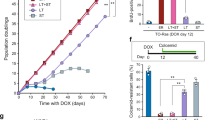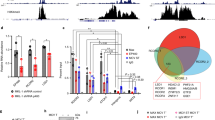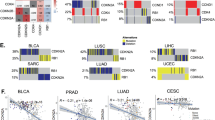Abstract
The oncoprotein of simian virus-40, SV40 large T-antigen (Tag), is reported to target and to inactivate growth suppressive proteins such as the retinoblastoma family1–3 and p53 (ref. 4, 5), leading to transformation of human cell lines in vitro, tumor production in rodents6, and detection of Tag in several human cancers including mesotheliomas7,8. The retinoblastoma family contains three members, pRb, p107 and pRb2/p130 (ref. 9), that are phosphorylated in a cell cycle-dependent manner10,11, have cell growth suppressive properties12 and bind to specific members of the E2F family and various cyclins13. Even though mesotheliomas are among the most aggressive human cancers, alterations of important cell-cycle “controllers,” such as the Rb family genes, have never been reported in these tumors. We found the presence of SV40-like sequences in 86% of 35 archival specimens of mesothelioma. We also demonstrated that SV40 Tag, isolated from frozen biopsies of human mesothelioma, binds each of the retinoblastoma family proteins, pRb, p107 and pRb2/p130, in four of four specimens. We propose that the tumorigenic potential of SV40 Tag in some human mesotheliomas may arise from its ability to interact with and thereby inactivate several tumor and/or growth suppressive proteins.
This is a preview of subscription content, access via your institution
Access options
Subscribe to this journal
Receive 12 print issues and online access
$209.00 per year
only $17.42 per issue
Buy this article
- Purchase on Springer Link
- Instant access to full article PDF
Prices may be subject to local taxes which are calculated during checkout
Similar content being viewed by others
References
DeCaprio, J.A. et al. SV40 large tumor antigen forms a specific complex with the product of the retinoblastoma susceptibility gene. Cell 54, 275–83 (1988).
Ludlow, J.W. et al. SV40 large T antigen bind preferentially to an underphosphorylated member of the retinoblastoma susceptibility gene product family. Cell 56, 57–65 (1989).
Stubdal, H., Zalvide, J. & DeCaprio, J.A. Simian virus 40 large T antigen alters the phosphorylation state of the RB-related proteins p130 and p107. J. Virol. 70, 2781–88 (1996).
Simmons, D.T. Transformation by polymaviruses: Role of tumor suppressor proteins. in: DNA Tumor Viruses: Oncogenic Mechanisms. (eds. Barbanti Brodano, G., Bendinelli, M. & Friedman, H.) 27–50 (Plenum, New York and London, 1995).
Sang, N., Baldi, A. & Giordano, A. The role of tumor suppressors pRb and p53 in cell proliferation and cancer. Mol. Cell. Differ. 3, 1–29 (1995).
Carbone, M., Rizzo, P. & Pass, H.I. Simian Virus 40, poliovaccines, and human tumor: a review of recent developments. Ocogene (in the press).
Carbone, M. et al. Simian virus 40-like DNA sequences in human pleural mesothe-lioma. Oncogene 9, 1781–90 (1994).
Bergsagel, D.J., Finegold, M.J., Butel, J.S., Kupsky, W.J. & Garcea, R.L. DNA sequences similar to those of simian virus 40 in ependymomas and choroid plexus tumors of childhood. N. Engl. J. Med. 326, 988–93 (1992).
Paggi, M.G., Baldi, A., Bonetto, F. & Giordano, A. The retinoblastoma protein family in cell cycle and cancer. J. Cell. Biochem. 62, 418–430 (1996).
Giordano, A., McCall, C., Whyte, P. & Franza, B.R. Human cyclin A and the retinoblastoma protein interact with similar but distinguishable sequences in the adenovirus E1 A gene product. Oncogene 6, 481–485 (1991).
Giordano, A. et al. Cell-cycle regulation of histone HI kinase activity associated with the adenoviral protein E1A. Science 253, 1271–1275 (1991).
Claudio, P.P. et al. p130/pRb2 has growth suppressive properties similar to yet distinctive from those of retinoblastoma family members pRb and p107. Cancer Res. 54, 5556–5560 (1994).
Claudio, P.P. et al. Functional analysis of pRb2/p130 interaction with cyclins. Cancer Res. 56, 2003–2008 (1996).
Fattaey, A.R., Harlow, E. & Helin, K. Independent regions of adenovirus E1 A are required for binding to and dissociation of E2F-protein complexes. Mol. Cell. Biol. 13, 7267–7277 (1993).
Vousden, K.H. Regulation of the cell cycle by viral oncoproteins. Semin. Cancer Biol. 6, 109–16 (1995).
Carbone, M. et al. Simian virus-40 large-T antigen binds p53 in human mesotheliomas. Nature Med. 3, XXX–YYY (1997).
Bartek, J., Vojtesek, B., Grand, R.J., Gallimore, P.H. & Lane, D.P. Cellular localization and T antigen binding of the retinoblastoma protein. Oncogene 7, 101–108 (1992).
Lewis, A.M., Jr. Experience with SV40 and adenovirus-SV40 hybrids. in: Biohazards in Biological Research. (eds. Hellman, A., Osman, M. & Pollack, R.) 96–113 (Cold Spring Harbor Laboratory Press, Cold Spring Harbor, New York, 1976).
Shah, K. & Nathanson, N. Human exposure to SV40: Review and comment. Am. J. Epidemiol. 103, 1–12 (1976).
Baldi, A. et al. The Rb2/p130 gene product is a nuclear protein whose phosphorylation is cell cycle regulated. J. Cell. Biochem., 59, 402–408
Baldi, A. et al. Differential expression of Rb2/p130 and p107 in normal human tissues and in primary lung cancer. Clin. Cancer Res. (in the press).
Baldi, A. et al. Differential expression of the retinoblastoma gene family members, pRb/p105, p107, pRb2/p130, in lung cancer. Clin. Cancer Res. 2, 1239–1245 (1996).
Author information
Authors and Affiliations
Rights and permissions
About this article
Cite this article
De Luca, A., Baldi, A., Esposito, V. et al. The retinoblastoma gene family pRb/p105, p107, pRb2/p130 and simian virus-40 large T-antigen in human mesotheliomas. Nat Med 3, 913–916 (1997). https://doi.org/10.1038/nm0897-913
Received:
Accepted:
Issue Date:
DOI: https://doi.org/10.1038/nm0897-913
This article is cited by
-
PI3 Kinase Pathway and MET Inhibition is Efficacious in Malignant Pleural Mesothelioma
Scientific Reports (2016)
-
Consistent gene expression profiles in MexTAg transgenic mouse and wild type mouse asbestos-induced mesothelioma
BMC Cancer (2015)
-
Immunodetection of SV40 T/t-antigens in Human Osteosrcoma in a Series of Tunisian Patients
Pathology & Oncology Research (2012)
-
Mineral fibre toxicity: expression of retinoblastoma (Rb) and phospho-retinoblastoma (pRb) protein in alveolar epithelial and mesothelial cell lines exposed to fluoro-edenite fibres
Cell Biology and Toxicology (2011)
-
Immunohistochemical expression of retinoblastoma and phospho-retinoblastoma protein in lung sheep exposed to fluoro-edenite fibers
Anatomical Science International (2010)



